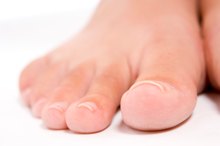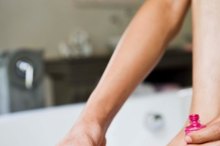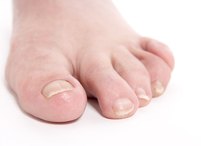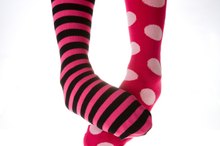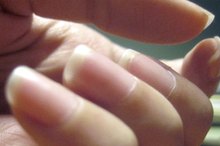What does fact checked mean?
At Healthfully, we strive to deliver objective content that is accurate and up-to-date. Our team periodically reviews articles in order to ensure content quality. The sources cited below consist of evidence from peer-reviewed journals, prominent medical organizations, academic associations, and government data.
The information contained on this site is for informational purposes only, and should not be used as a substitute for the advice of a professional health care provider. Please check with the appropriate physician regarding health questions and concerns. Although we strive to deliver accurate and up-to-date information, no guarantee to that effect is made.
Ingrown Toenail on the Pinky
An ingrown toenail is a condition in which the side of the nail grows into the soft flesh of the toe itself. This painful condition can occur on any of the metatarsals and is especially common on the big toe but can be particularly troublesome when it occurs on the pinky. Because the pinky toe is the smallest digit, it makes proper trimming of the nail difficult.
Symptoms
You know you have an ingrown pinky nail when you visually examine it for evidence of a nail growing into the flesh. The toe is likely to be sore, red and swollen in this area. It may also be draining fluid, a sign of infection.
Causes
How to Flatten a Curved Toenail
Learn More
An ingrown toenail occurs due to several reasons, including improper trimming in which the nail is cut too closely or is not trimmed straight across. Injury to the nail can also result in a nail growing into the fleshy part of the toe. You can also suffer from an ingrown pinky toe if you wear shoes that are too narrow. Finally, some people’s nails naturally grow in a curving manner than can cause ingrowth.
- An ingrown toenail occurs due to several reasons, including improper trimming in which the nail is cut too closely or is not trimmed straight across.
- Injury to the nail can also result in a nail growing into the fleshy part of the toe.
Treatment
Treat your ingrown nail at home by soaking your affected foot in warm water several times a day. Keep your feet dry at all other times. Wear open-toed sandals until your pinky toe heals. Apply a small amount of antibiotic cream to the affected area. According to the American Academy of Orthopaedic Surgeons, you might need to lift the nail slightly from the area in which it is embedded and insert a piece of waxed floss or small piece of cotton beneath in between the nail and the flesh 1. Change out the floss every day. Consult a physician, if your condition fails to improve after a week. A doctor may need to remove or partially remove the nail if the condition cannot be remedied by other methods, or if the infection is severe.
- Treat your ingrown nail at home by soaking your affected foot in warm water several times a day.
Prevention/Solution
What to Do for a Ripped-Loose Fingernail?
Learn More
The best way to prevent ingrown nails is to take good care of your feet. Wear comfortable shoes that do not crowd the toes. Also, learn to trim your toenails straight across rather than rounding them. Leave your nails a little long rather than risk cutting too close. Pay particular attention to the pinky toe as it is the most difficult to trim.
- The best way to prevent ingrown nails is to take good care of your feet.
- Also, learn to trim your toenails straight across rather than rounding them.
Warning
Do not delay seeking professional treatment for an ingrown pinky nail if you are a diabetic or suffer from any circulation impeding ailment. MayoClinic.com warns that if an ingrown toenail is left untreated, there is the possibly of the infection spreading into the bone itself, causing a serious medical condition 2.
Related Articles
References
- American Academy of Orthopaedic Surgeons: Ingrown Toenail
- MayoClinic.com: Ingrown Toenails
- Dąbrowski M, Litowińska A. Recurrence and satisfaction with sutured surgical treatment of an ingrown toenail. Ann Med Surg (Lond). 2020 Jun 26;56:152-160. doi: 10.1016/j.amsu.2020.06.029. PMID: 32637092; PMCID: PMC7330155.
- Haneke E. Controversies in the treatment of ingrown nails. Dermatol Res Pract. 2012;2012:783924. doi: 10.1155/2012/783924. PMID: 22675345; PMCID: PMC3362847.
- Miquelão Canuto Verussa MJ, Biselli Boarini LM, Gabbi T. "Super U" technique for ingrown nails: a tertiary hospital experience between 2011 and 2018. Int J Dermatol. 2019 Oct 24. doi: 10.1111/ijd.14694. Epub ahead of print. PMID: 31650538.
- Arica IE, Bostanci S, Kocyigit P, Arica DA. Clinical and sociodemographic characteristics of patients with ingrown nails. J Am Podiatr Med Assoc. 2019 May;109(3):201-206. doi: 10.7547/17-023. PMID: 31268783.
- Mayeaux EJ Jr, Carter C, Murphy TE. Ingrown toenail management. Am Fam Physician. 2019 Aug 1;100(3):158-164. PMID: 31361106.
- Sánchez LC, Zalacaín-Vicuña AJ. Onychoplasty with 1064-nm Laser: Matrixectomy for Treatment of Ingrown Toenails. J Am Podiatr Med Assoc. 2019 Sep;109(5):401-406. doi: 10.7547/17-008. PMID: 31599675.
- Muriel-Sánchez JM, Becerro-de-Bengoa-Vallejo R, Montaño-Jiménez P, Coheña-Jiménez M. The treatment of ingrown nail: Chemical matricectomy with phenol versus aesthetic reconstruction. A single blinded randomized clinical trial. J Clin Med. 2020 Mar 20;9(3):845. doi: 10.3390/jcm9030845. PMID: 32244966; PMCID: PMC7141528.
- American Academy of Family Physicians. Ingrown toenails. January 4, 2018.
Writer Bio
Lisa Mooney has been a professional writer for more than 18 years. She has worked with various clients including many Fortune 500 companies such as Pinkerton Inc. She has written for many publications including Woman's World, Boy's Life and Dark Horizons. Mooney holds bachelor's degrees in both English and biology from the University of North Carolina at Charlotte.
